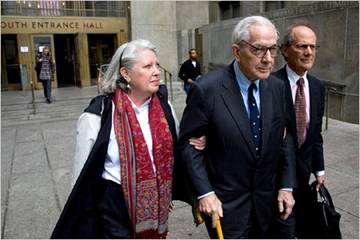|
The Rich Aren’t So Different
By
Paula Span, The New-York Times
May
4, 2009

John Marshall Mantel for The New York Times. Anthony Marshall, center, his wife Charlene Marshall and lawyer Ken Warner. Mr. Marshall is on trial for conspiracy and scheming to defraud the estate of his mother, socialite Brooke Astor.
The name of the alleged victim carries potent overtones: Astor. The objects, the settings, the amounts of money involved are all extraordinary. Most suspected victims of elder abuse don’t alternate between sprawling, antique-filled Park Avenue apartments and verdant Westchester County estates. And if an adult child is accused of stealing from a frail parent, the purloined object is unlikely to be a Childe Hassam painting that can promptly be sold for $10 million.
In the family drama that began unfolding in a Manhattan courtroom last week — Anthony Marshall, 84, only child of the celebrated New York philanthropist Brooke Astor, is on trial with estate attorney Francis X. Morrissey Jr., 66, for conspiracy and scheming to defraud his mother — the witness list is full of boldface names. Most cases involving suspected financial exploitation of the elderly, by contrast, are never prosecuted and probably never discovered.
Nevertheless, to professionals in the field, many aspects of the Astor case feel quite familiar. “It’s not just happening to the Astors; it can happen to people on your block,” said Sharon Merriman-Nai, co-manager of the National Center on Elder Abuse.
Mrs. Astor had been diagnosed with Alzheimer’s disease, the most common form of dementia. Prosecutors contend that she couldn’t understand the changes she was induced to make to her will at age 101; the defendants deny having taken advantage of her impairment. It’s a situation that elder law attorneys, geriatric physicians and advocates for the elderly see all too often.
Trying to specify exactly what behavior constitutes elder abuse can be a quick way to start an argument, as readers here have seen. It remains a shadowy, insufficiently investigated subject; reliable statistics on how commonly it occurs are hard to come by. But the National Center on Elder Abuse definition includes “financial or material exploitation,” from cashing an elder’s check without permission to “coercing or deceiving an older person into signing any document.”
Though all kinds of elder abuse are believed vastly underreported, this variety can be particularly hard to ferret out. Neglect and physical abuse “are more likely to come to medical attention, to raise suspicion, to get reported,” said Richard Bonnie, the University of Virginia law professor who co-chaired a National Research Council panel on elder mistreatment. “Financial exploitation by caregivers and family members is less visible, harder to detect.”
Yet data from 19 states, part of a University of Kentucky survey (PDF) of adult protective services agencies for the National Center on Elder Abuse, indicates that about 15 percent of substantiated reports of abuse involved financial exploitation. Mr. Bonnie thinks the incidence may well be twice as high.
“It’s very common, people preying financially on people with Alzheimer’s,” said Dr. Laurel Coleman, an Augusta, Maine, geriatrician and national board member of the Alzheimer’s Association. “They become ripe for abuse.”
Nor is it unusual for relatives to be involved. The most common abusers of the elderly are adult children and other family members, the same study found. In cases of financial deception, families fear and look out for swindlers and scam artists — a bona fide danger. But a recent overview in Clinical Geriatrics noted that the most likely perpetrators are “family members, friends and caregivers, who feel entitled to take funds because of their established relationship.”
As for assessing the mental capacity of an Alzheimer’s sufferer, on which a verdict in the Astor trial may well depend, “families really struggle with this,” Dr. Coleman said. It’s no simple calculation. People commonly associate Alzheimer’s disease — which afflicts more than 40 percent of the population over age 85, according to research conducted for the Alzheimer’s Association — with memory loss. But “judgment, calculation, reasoning, use of language are also affected,” Dr. Coleman cautioned, and a person competent to make certain kinds of decisions (what do I want to wear today?) may not be competent to reach others (should I sign this piece of paper?).
The Astor trial could help spotlight such thorny matters. “A sensational case like this, or the Terry Schiavo case, hits the hot button and helps make people aware that there could be a problem and that they should protect themselves,” said Craig Reaves, president of the National Academy of Elder Law Attorneys, whose 4,000 members are watching with interest.
“On the other hand,” Mr. Reaves added, “it’s so sad to see anyone go through this. The son. The mother. I’m sure she’d be mortified.”
Paula Span is the author of “When the Time Comes: Families with Aging Parents Share Their Struggles and Solutions,” to be published next month by Grand Central Publishing.
More Information on US Elder Rights Issues
Copyright © Global Action on Aging
Terms of Use |
Privacy Policy | Contact
Us
|



